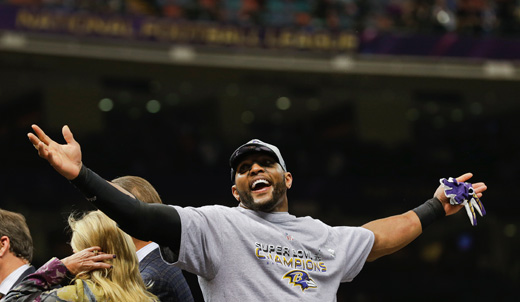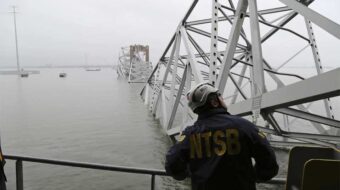
Super Bowl 47 offered football fans an incredibly dramatic game that saw the Baltimore Ravens edge the San Francisco 49ers, 34-31. But there was a multitude of drama even before the first snap commenced.
Baltimore Ravens linebacker and longtime LGBT equality activist Brendon Ayanbadejo made the news for his public willingness to use the Super Bowl media frenzy to forward the causes of combatting anti-LGBT bullying and supporting marriage equality. However, when the issue of homophobia was addressed at the Super Bowl, it wasn’t Ayanbadejo at the center of the debate.
There was relatively little discussion about the NFL-affiliated gospel celebration that starred a number of anti-gay-equality performers and preachers, because the media zeroed in on something else. During an interview, San Francisco 49ers defensive end Chris Culliver stated his intolerance for gay people and his animosity to even having possible gay teammates, saying, “No, we don’t got no gay people on the team. They gotta get up out of here if they do.”
These comments were compounded when two teammates – Ahmad Brooks and Isaac Sopoaga – denied participating in the team’s “It Gets Better” video. The It Gets Better campaign – which seeks to empower the victims of anti-gay bullying through video statements of solidarity by celebrities – took down the Niners’ video, marking the first time the campaign has ever pulled a video.
These Super Bowl happenings certainly highlight the very real limitations of victories for inclusiveness in the NFL. They also become a teachable moment. Pressure from the public, the 49ers, Coach Harbaugh and his loved ones caused Culliver to issue an unequivocal apology. He also announced that he will undergo sensitivity training and volunteer with groups like The Trevor Project to become better educated and raise awareness. So, while there are still problems with homophobia in sport, it is safe to say that it is getting better.
Meanwhile, on Sunday morning, NFL Commissioner Roger Goodell appeared on “Face the Nation.” Unsurprisingly, Goodell dodged questions about the link between football, concussions and long-term brain injuries like chronic traumatic encephalopathy, a trauma-induced brain disorder.
This is the same sport that is being sued by over 3,000 former players and their families for not giving the players the information needed to give informed consent to play – either through not investigating the possible long-term health risks or keeping the extent of those risks from the players.
It is the same sport that, until 2009 when Congress threatened their anti-trust exemption, had their head neurologist denying links between being hit in the head and long-term brain injuries despite lots of new research showing the damning effects of football on the human brain.
This is also the same sport that has seen over 90% of players polled say that they do not trust their team doctors to meaningfully care for a player’s long-term health.
And this is the same commissioner who has tried to publicize his desire to care for player health and safety while asking for more regular season games.
The game itself had an embarrassingly problematic moment when the Superdome saw the power go out in part of the stadium. By Sunday evening, there were already questions about whether or not the Superdome would be able to host any more games unless they get an influx of public cash or, as Forbes noted, a brand new stadium.
Since 2005, the New Orleans stadium has received $471 million in public subsidies. As a recent Bloomberg article noted: “Talks headed by then-NFL Commissioner Paul Tagliabue led to a plan to fix and renovate the Superdome with $121 million from the state, $44 million from the Louisiana Stadium and Exposition District, which oversees the facility, $156 million from the Federal Emergency Management Agency and $15 million from the league. …Ultimately, the financing cost the district more than three times its $44 million commitment.”
“In April 2009, Louisiana negotiated a new lease to … keep the team in New Orleans through 2025. The state made $85 million in fresh Superdome improvements, adding luxury seating and moving the press box.”
Of course, this is representative of the vast majority of major sporting activities in the United States: We socialize the costs while privatizing the profit of major ventures like the Super Bowl and use the brief power outage as an excuse to shill for millions more to be spent on another stadium while social services and programs are underfunded.
But at least the commercials couldn’t be political, right? Wrong. SodaStream attempted to highlight its environmental friendliness as well as opposing the major soda corporations. But SodaStream is the subject of its own boycott by peace activists and Israeli boycott/divestment/sanctions (BDS) activists since the factory that produces SodaStream’s devices is in an illegal Israeli settlement in the heart of the occupied West Bank.
Super Bowl 47 brought us some beautiful football highlights- Kaepernick’s tremendous play, Flacco’s MVP performance, etc. – and some embarrassing lowlights (including, quite literally, the blackout).
The excesses of corporate capitalism and homophobia have the opportunity to be countered by some gorgeous social justice resistance. Instead of denunciations of sport, we can celebrate the beauty while using it as a vehicle to discuss social justice issues. Let’s not punt this away.
Photo: Baltimore Ravens linebacker Ray Lewis (52) celebrates after defeating the San Francisco 49ers 34-31in the NFL Super Bowl XLVII football game, Feb. 3, in New Orleans. Dave Martin/AP












Comments